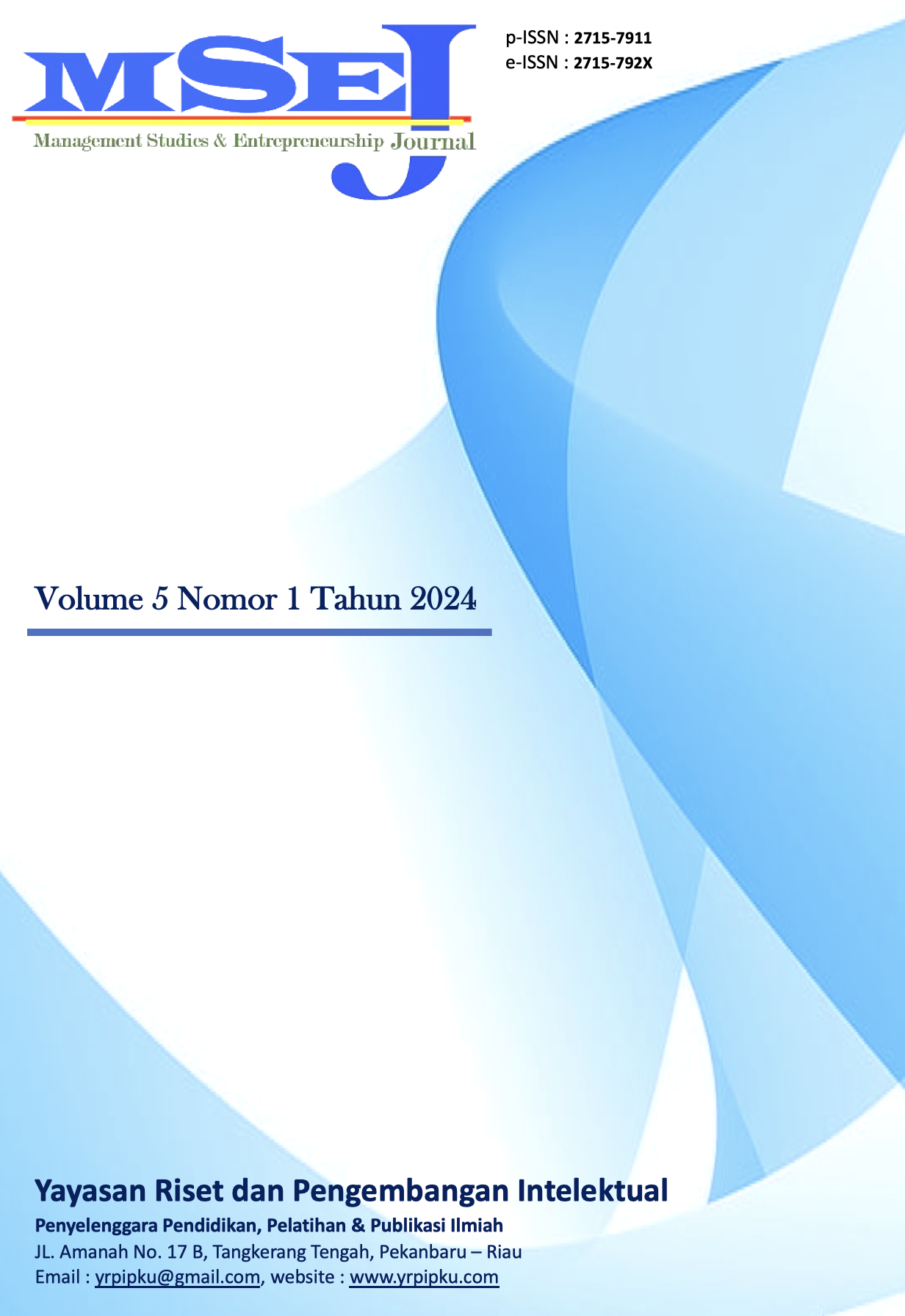Analisis Resource-Based View Sebagai Strategi Untuk Meningkatkan Keunggulan Kompetitif Pada CV Mubarokfood Cipta Delicia
DOI:
https://doi.org/10.37385/msej.v5i1.4391Keywords:
Keunggulan Kompetitif; Industri Makanan Dan Minuman; Kemampuan Internal; Resource-Based View; Manajemen StrategisAbstract
Penelitian ini mengkaji bagaimana Resource-Based View (RBV) yang memanfaatkan kerangka kerja VRIO menjadi strategi untuk meningkatkan daya saing CV Mubarokfood Cipta Delicia di industri makanan dan minuman. Fokusnya adalah mengidentifikasi dan memahami sumber daya strategis dan kemampuan internal perusahaan yang dapat memberikan keunggulan kompetitif. Penelitian ini menggunakan metodologi deskriptif kuantitatif yang melibatkan observasi, wawancara, dan analisis data. Temuan menunjukkan bahwa Delicia memiliki 13 sumber daya dan 8 kemampuan yang berkontribusi pada keunggulan kompetitif dalam aktivitas infrastruktur, aktivitas HRM, Inovasi Produk, dan aktivitas Reputasi Merek, seperti produksi dan distribusi, sumber daya keuangan, kemampuan organisasi, dan manajemen perusahaan. Hasil yang diidentifikasi digunakan untuk perencanaan strategis untuk membantu Mubarokfood mencapai keunggulan kompetitif yang berkelanjutan. Evaluasi ini juga menekankan pentingnya berinvestasi dalam teknologi informasi, manajemen keuangan, manajemen hubungan pelanggan, strategi data dan digital, dan manajemen kinerja.
References
Ben Youssef, A., Boubaker, S., & Omri, A. (2018). Entrepreneurship and sustainability: The need for innovative and institutional solutions. Technological Forecasting and Social Change, 129, 232–241. https://doi.org/10.1016/j.techfore.2017.11.003
Bobillo, A. M., López-Iturriaga Felix, F., & Tejerina-Gaite, F. (2010). Firm performance and international diversification: The internal and external competitive advantages. International Business Review, 19(6), 607–618. https://doi.org/10.1016/j.ibusrev.2010.03.006
Borchert, O. (2008). Resource-Based Theory: Creating and Sustaining Competitive Advantage. Journal of Marketing Management, 24(9–10), 1041–1044. https://doi.org/10.1362/026725708x382046
Cheng, J. H., Lei, D. Y., Huang, K. P., & Feng, Y. L. (2020). Based on social capital to discuss the correlation between internal marketing strategy and employees’ job satisfaction in medical equipment industry. Revista de Cercetare Si Interventie Sociala, 71. https://doi.org/10.33788/rcis.71.14
Citraresmi, A. D. P., Rucitra, A. L., Haryati, N., & Amalia, F. (2021). Resource-based view model implementation toward business competitiveness (Case study in mushroom SMEs in Malang, Indonesia). Advances in Food Science, Sustainable Agriculture and Agroindustrial Engineering, 4(1), 18–24. https://doi.org/10.21776/ub.afssaae.2021.004.01.3
Collins, C. J. (2021). Expanding the resource based view model of strategic human resource management. International Journal of Human Resource Management, 32(2). https://doi.org/10.1080/09585192.2019.1711442
David, F. R. (2010). Manajemen Strategis?: Konsep. Buku 1, Edisi Kedua Belas, Terjemahan oleh Dono Sunardi.
David, F. R., & David, F. R. (2015). Strategic Management: Concepts & Cases. June, 690.
E-bpom.pom.go.id. (2023). SURAT KETERANGAN PER KOMODITI.
Freeman, R. E., Dmytriyev, S. D., & Phillips, R. A. (2021). Stakeholder Theory and the Resource-Based View of the Firm. Journal of Management, 47(7). https://doi.org/10.1177/0149206321993576
Friedrich von den Eichen, S., Freiling, J., & Matzler, K. (2015). Why business model innovations fail. Journal of Business Strategy, 36(6). https://doi.org/10.1108/JBS-09-2014-0107
Ganesan, V. (2021). Surviving The Impact of Covid-19: Pandemic leaves retailers feeling dejected. The Edge Market.
Gerhart, B., & Feng, J. (2021). The Resource-Based View of the Firm, Human Resources, and Human Capital: Progress and Prospects. Journal of Management, 47(7). https://doi.org/10.1177/0149206320978799
Gibson, C. B., Gibson, S. C., & Webster, Q. (2021). Expanding Our Resources: Including Community in the Resource-Based View of the Firm. Journal of Management, 47(7). https://doi.org/10.1177/0149206320987289
Giustiziero, G., Kretschmer, T., Somaya, D., & Wu, B. (2023). Hyperspecialization and hyperscaling: A resource-based theory of the digital firm. Strategic Management Journal, 44(6). https://doi.org/10.1002/smj.3365
González-Díaz, R. R., Acevedo-Duque, Á. E., Guanilo-Gómez, S. L., & Cachicatari-Vargas, E. (2021). Business counterintelligence as a protection strategy for SMEs. Entrepreneurship and Sustainability Issues, 8(3), 340–352. https://doi.org/10.9770/jesi.2021.8.3(21)
Greche, M., Hosseini, S. M., & Taheri, M. (2019). A Comprehensive Literature Review in Competitive Advantages of Businesses. International Journal of Advanced Studies in Humanities and Social Science, 8(3), 223–240. https://doi.org/10.33945/sami/ijashss.2019.3.1
Hyder, S., & Lussier, R. N. (2016). Why businesses succeed or fail: a study on small businesses in Pakistan. Journal of Entrepreneurship in Emerging Economies, 8(1). https://doi.org/10.1108/JEEE-03-2015-0020
Lexy J Moleong. (2013). Metodologi Penelitian Kualitatif. Edisi Revisi. PT Remaja Rosdakarya.
Nugroho, T. T., Najib, M., & Kirbrandoko, K. (2018). Penentuan Daya Saing Berbasis Analisis Kompetensi Inti (Studi Kasus Pada Ekowisata Bakau Di Jawa Timur). Matrik?: Jurnal Manajemen, Strategi Bisnis Dan Kewirausahaan, 25–32.
Sugiyono, P. D. (2019). Metode Penlitian Kuantitatif, Kualitatif, dan R&D. 334.
Syaifudin, A. (2015). Metode penelitian. Yogyakarta?: Pustaka Belajar.
Yang, T., & del Carmen Triana, M. (2019). Set Up to Fail: Explaining When Women-Led Businesses Are More Likely to Fail. Journal of Management, 45(3). https://doi.org/10.1177/0149206316685856

 Template
Template






